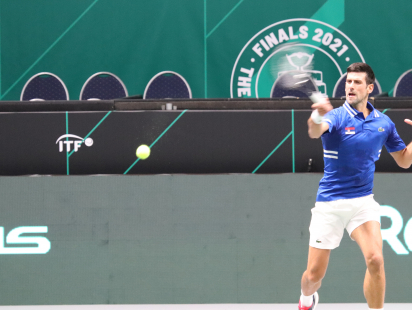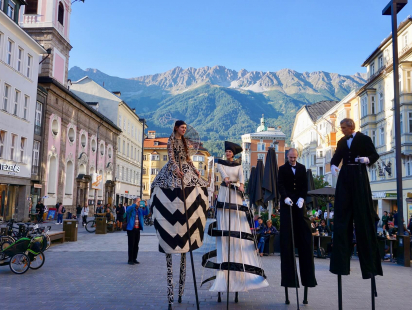Telfs is the third-largest municipality in Tirol, and it has just held its five-yearly traditional carnival (Fasnacht), the Schleicherlaufen, on 2 Feb 2020. Since the Schleicherlaufen happens so rarely, I already set a reminder in my (digital) calendar for it three years ago!
The Telfer Schleicherlaufen is on the UNESCO‘s Intangible Cultural Heritage list, and its core groups were formed around 1830. The villagers pride themselves on this tradition, and there are many Schleicherlaufen-related public artworks in Telfs.

The Laternenträger fountain, made by artist Martin Gundolf © Ichia Wu
Telfer Schliecherlaufen Pre-parade Events
Tirolean Fasnacht parades are set on a specific day around early February (each village picks its own date) and a few villages offer a children’s version on a separate day, much like the Notting Hill Carnival in the UK. What Tiroleans do differently is that, before the actual parade, there are already many warm-up events starting from January. It is common to watch Fasnacht groups perform (at a smaller scale) in local inns or guest houses and many groups also host balls. These performances are like excerpts of the main Fasnacht parade.
On the other hand, in Telfs, the pre-parade events are not segments of the parade but events in their own right. The grand parade cannot stand alone without these pre-and-post-parade events because together they form a complete narrative. These events are not repeated during the Fasnacht parade! As a result, to understand the Schleicherlaufen as much as possible, I visited Telfs several times this month.
Nazausgraben — Naz is freed!
“Naz” is the child puppet as seen in the pictures below. The first event of the series, “Nazausgraben” marks the opening of every Fasnacht period in Telfs. Naz is the materialization of the Fasnacht itself, and this ceremony was to dig him up from a pile of gravel. This was of course because Naz was “buried” five years ago at “Nazeingraben”, which ended the previous Fasnacht (which this year falls on 25 Feb).

Nazausgraben, 6 Jan 2020 © Ichia Wu
After Naz was dug out and reunited with his mom and nanny, each performing group of the Schleicherlaufen congratulated Naz with humorous lines and showered him with gifts. Naz also performed his signature tricks which I will reveal later in this article.
Although the temperature was minus 3 degrees Celsius, a lot people braved the cold to attend this key event. We were not disappointed – the event presentation was really enjoyable! There were a lot of rhymed satirical jokes and judging from the laughter, they were really funny. The scandalous “Ibiza-Video” from 2019 was also made fun of.
Viechertaf — You are good to go!
Another event was called “Viechertaf“. Before taking part in the actual Schleicherlaufen, the antique and vintage animals had to go through a health check — “Viechertaf” — for their own good.

Health check “Viechertaf” was performed on an ostrich, a llama, an elephant, a camel and a turtle. © Ichia Wu
Professional doctors were entrusted to carry out this potentially hazardous task which was also laugh-inducing to the spectators. Some animals were vaccinated and the elephant had one of his teeth pulled (a small one). After the event, children were invited to go on the stage for a better look at the animals, which was really a nice touch.
Pub Crawl
During the Fasnacht season from Thursday to Saturday, many pop-up evening bars in Telfs opened their doors and were busy serving drinks. These “bars” were actually extensions of parade wagons and each performing group set one up at its own base. They were scattered all over the town and it would be easier to navigate if you tag along with someone local. When a group visited another, they made special chants to greet each other. Since the wagons were painstakingly designed and made, no wonder people found this clever way to enjoy them to the fullest. These hubs also strengthened the bond within the groups, I imagine.

At the Schleicher bar I met lovely Mr. Gerhard Körber, the Schleicher who started the earring custom in the group. Each badge on his hat marked a Schleicherlaufen he participated in (eight times and counting at that time). © Ichia Wu
There were many more pre-parade events highlighting individual groups or dedicated to wagons. The best place to find the full schedule (Terminübersicht) is to visit the local government’s website AND the official Facebook page of Schleicherlaufen.
On the day of the Schleicherlaufen
Uh-oh. The whole town was in thick fog and according to weather broadcast, it would even start raining around noon. Therefore, the first programme of the day was particularly significant: through the worship of the Sun, the village pleaded for good weather. This tradition started in 1890 after being teased by Telfs’ southern neighbours about poor weather. Since then, the weather was always good on Schleicherlaufen days.
This was one of those “if you miss it, you miss it” events. The procession started around 7AM in the dark and by the time it arrived at the sixth stage, the night had faded. After the worship, spectators were offered pretzels and dried sausages.

The Sonnenanbeter kneed down to worship the sun. The character holding a piglet was a Chimney Sweep. © Ichia Wu
Before the 11AM grand parade, there were side events to entertaining us, such as the Wilden‘s parade at 8:45 and the “Bear-catching” at 10:00. Meanwhile, beautiful Schleicher rode separately in horse-drawn carriages through town towards the assembly. Their hats were then displayed in a garden for inspection. A lot was going on — albeit at different locations. That’s why I think the event planners had the audience’s enjoyment in mind.

Elegant! © Ichia Wu

Surely bears had to be caught in the wild, so watching it here was meaningful. The “dance” could be also seen in the actual parade. © Rafael Haas
The Schleicherlaufen Begins
After loud gunfire, the Heralds rode in to announce the beginning of the main event. The sun actually shined through the clouds at this point!

The Herolde group © Ichia Wu
Next came the Musibanda and their catchy songs. The spectators gladly sang along. One song is still in my head.

This year the theme was “Blues Brothers”. © Ichia Wu
They were followed by the quiet but romantic Four Seasons. In 1955 this group was formed to represent Austrian federal states but since 1960, they presented the seasons instead.

Vier Jahreszeiten © Ichia Wu
The Wilden
Banging his cymbals hard, the Panzenaff was brought in by the Wilden. His barrel doubled as a drum. To qualify for this role, the candidate must have a long tongue and be willing to EXTRACT his lower front teeth to extend his tongue further out! The pulled teeth were then made into a charm to be hung next to the predecessors’ teeth on a chain (seen here worn on the chest of Dr. Herbert Hauser).
The Wilden (Wild Men/Savages) wore costumes made of tree beards (lichen) and let out deep and loud roars. Their original duty was now taken over by the event security team. Eating tree beards is actually a part of the inauguration for new members. The tree beards are said to taste neutral.

Mr. Walter Stubenböck is the new Panznaff. © Ichia Wu

The Panzenaff got off his cart to interact with the spectators, which was a new routine. © Ichia Wu
The Schleicher
Before the Schleicher came into position, the Laternenträger (Lantern Carrier) swung in to clear the space. Rotating with his lantern, he used it to hit those who were not smart enough to back way!

The Laternenträger’s hat was decorated with corn kernels and he was wearing a different earring this time. © Ichia Wu
The first Schleicher was wearing a very tall hat lent by the local Fasnacht museum. I have tried lifting a few hats before and some were seriously heavy. A handkerchief was stitched on each Schleicher’s left glove.

The Schleicher entered the stage and I counted 56 of them. © Ichia Wu

© Ichia Wu

The hats were exhibited later on that day in the Town hall. © Ichia Wu
They walked in one line and gradually formed a circle (Kroas) for their ritual. Along the way they distributed (often by throwing) unglazed pretzels to the spectators.

The pretzels symbolized good luck. © Ichia Wu
The bells carried by the Schleicher do not make meaningless noises. In fact, the Schleicher walk steadily to avoid ringing the bells which only clang during the ritual “Schleichertanz“. This is why they are called Schleicher – the “Sneakers“.
Another set of characters positioned themselves within the circle and one of them is the “Wirt (Innkeeper)” who read out the names of honoured guests from a list. The Schleicher then hopped forward during the interval of list reading and some characters danced to the same rhythm. A video of the dance filmed in 1930 can be viewed here.

The Schleicher formed a Kroas. © Ichia Wu
The Bears and the Exoten
Remember the bears caught earlier in the morning? Now we had the chance to see how they were tamed. After some fight, the bear started mirroring the slow movement of the Bärentreiber, as if they were hypnotized. The Bärentreiber then put a long stick over their bear’s shoulders and the bear could no longer attack with its claws. Interesting!

The bears and the Bärentreiber © Ichia Wu
How about the Exoten? They appeared at the same time as the bears and it was an explosion of actions! So many dazzling characters and animals were moving, running, bouncing while energetic music was being played.

It was the Giraffi’s debut in the Telfer Schleicherlaufen! And the camel dates back to 1905. © Ichia Wu
Another highlight: the “Krouta” (Turtle) was waken up from its hibernation and CRAWLED down the slope! The wagon then became the stage for various acrobats.

The “Krouta” symbolizes fertility. © Ichia Wu

Dynamic performance of the Exoten © Ichia Wu
The Laninger Family
The last of the traditional groups was the “traveler family” Laninger. Their beloved kid Naz sat with his nanny at the front of the vardo. Whenever Naz gets a new nanny, he also gets a new dress. The current dress was given to him in 2015 and the old one worn from 1970 to 2010 is now in the local Fasnacht Museum.

The rest of the family walked between the vardo and their Fasnacht wagon which was used as a stage for acting and singing. © Ichia Wu
Naz amused the spectators with his famous tricks: cigarette smoking and spiting!

Naz and his nanny (Kindsdirn) Karl Walch © Ichia Wu
The wagons
In a bit of rain the parade of wagons started. I have no idea how this respectable head below was built. There was even a huge Star Trek Enterprise rising from another wagon!

The Vogler group started working on their wagon since August last year. © Ichia Wu
Finished…. for the day
The cemetery at the parish Church was the final (7th) stage of the Schleicherlaufen but only the Schleicher group performed there, as it was the remembrance of the Fasnacht members who passed away. There are still a few post-parade events (such as group beard-shaving) until Naz gets buried again on 25 Feb.
This has become a very long article and I thank you for reading. Time to mark the calendar for the 2025 Schleicherlaufen! !

The parish Church Peter and Paul © Ichia Wu
Rate this article
Show me the location on the map
Ichia Wu is a Taiwanese artist with broad experience in the tourism sector. Since relocating to Innsbruck, she has become an ardent enthusiast of the traditional carnival celebrations ("Fasnacht") in Tyrol.
Similar articles
Every year, our Bergisel ski jump takes center stage in the world of winter sports. This…
Alone, in pairs or all together? A question that tingles our bellies again, especially at the upcoming…
From November 25 to 30, 2021, the Davis Cup met for the final round in…
The night life of Innsbruck is hopping, at least it was the first weekend in October! It…





